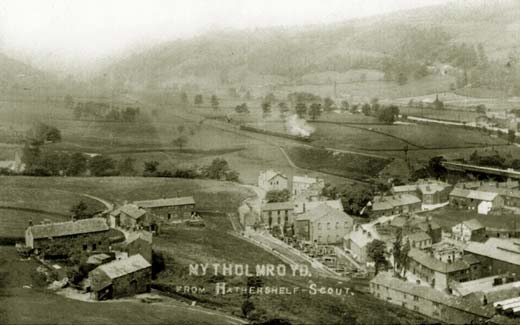History Society Report
Mytholmroyd: the development of a Pennine village
Speaker: Rodney Collinge
Tuesday, 31 January 2017
Rodney Collinge was both a pupil and a teacher at Calder High School, and now as he looks out on those familiar hills, he likes to imagine the people who have walked those tracks in the past. In a comprehensive talk to Hebden Bridge Local History Society, Rodney described how developments from the Ice Age to the end of the 19th century have left their marks on the area.
Click photo to enlarge
The glacial melt gouged out the steep-sided valleys, and early people from the stone age, bronze age and iron age forged their living on the hill tops, leaving evidence in the form of flints, stone tools and signs of burial sites, hill forts and stone circles. The Romans too have marched across these hills – the road from Ilkley to Manchester passed through Luddenden and Wainstalls. In the 1950s a hoard of Roman coins was found close to where the river was forded, possibly suggesting a settlement there, and archaeologists are still hoping for evidence of a Roman fort in the Sowerby area.
Place name evidence points to later invaders and settlers with –royd and –ley being common word endings from Anglo-Saxon while –by –gate and –rake have Viking origins. The name Mytholmroyd comes from its place at the meeting of two rivers.
In the time of the Domesday book, there were about thirty households, farmsteads scattered on the hillsides, and this pattern of development persisted for many years, with much of the area being kept for hunting by the lord of the manor as protected ‘forest’ and ‘park’.
The Middle Ages saw the development of the textile trade, with most of the production carried out in the home. There is some landscape evidence of this textile production, with a ‘stretchergate’ in Midgley where the yarn would be stretched and strengthened, and ‘tenterfields’ in Luddenden where the woven pieces would be stretched on tenters.
The move to producing the finer worsted cloths saw the growth of a prosperous class of yeomen/clothiers whose fine 16th and 17th century stone houses are such a feature of our landscape. Increasing innovation and mechanisation led to the building of ever bigger mills, and the movement of the population to the valley bottoms. Both the remaining mills and the rows of workers’ cottages remind us of that age.
The story of Mytholmroyd, like many Calder Valley towns and villages then became a story of increasing civic organisation, with elected officers charged with keeping the peace, ensuring the poor were cared for and transport links kept in good repair.
The story of the Cragg Vale coiners might be reminiscent of the Wild West but, bit by bit, chapels and churches, roads, canals and railways contributed to the development of an ordered town with a strong sense of community. That sense of community is only strengthened by an awareness of the past and the people who have lived here before us.
Everyone is welcome at meetings of the Hebden Bridge Local History Society, held fortnightly at 7.30 on Wednesdays at the Methodist Church in Hebden Bridge, with the next meeting on 8th February. Mike Crawford will give the Alan Petford memorial lecture looking at the People, Puzzles and Earning a Living as revealed in a study of 17th century wills and inventories.
Details of all the society’s activities can be found on our website www.hebdenbridgehistory.org.uk and you can also follow us on our Facebook page.
With thanks to to Sheila Graham for this report
See also



